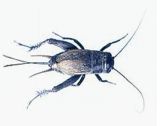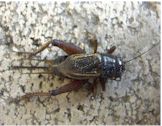

- Have long, slender antennae and a typical stout body (more robust than the house cricket) with large "jumping" hind legs.
- The ovipositor may be up to 3/4 inch long.
- Females have three easily seen appendages coming out of the tip of the abdomen, whereas males have only two.
- Most chirp and may sing both day and night.
- Field Crickets over winter as eggs or nymphs in moist, firm soil.
- Each female lays between 150 to 400 eggs, which hatch in the spring.
- Nymphs resemble adults except are smaller and wingless, molt eight to nine times and reach adulthood in about 90 days.
- Outdoors, high numbers of crickets can damage garden plants.
- Indoors, crickets can damage natural and synthetic fabrics, furs and carpeting.
- Prevention begins with reducing the amount of grass and weeds, and removing woodpiles away from buildings.
- Seal entry points around windows and doors and other holes. Install screens on windows and doors.
- Control can also be achieved using registered pesticide baits
applied in a band between the buildings and grassy places
 outdoors.
outdoors. - For indoor infestations treatment of cracks and crevices may be necessary.
- A vacuum may be used to mechanically remove crickets.